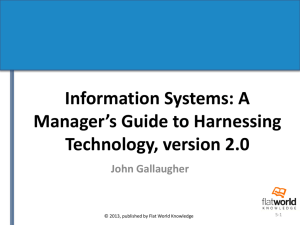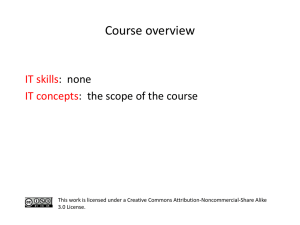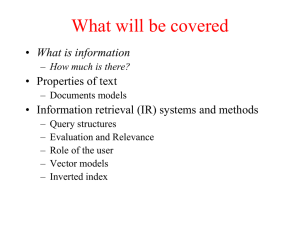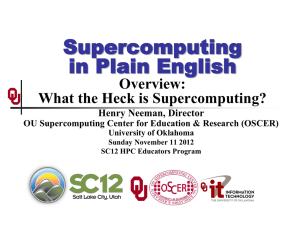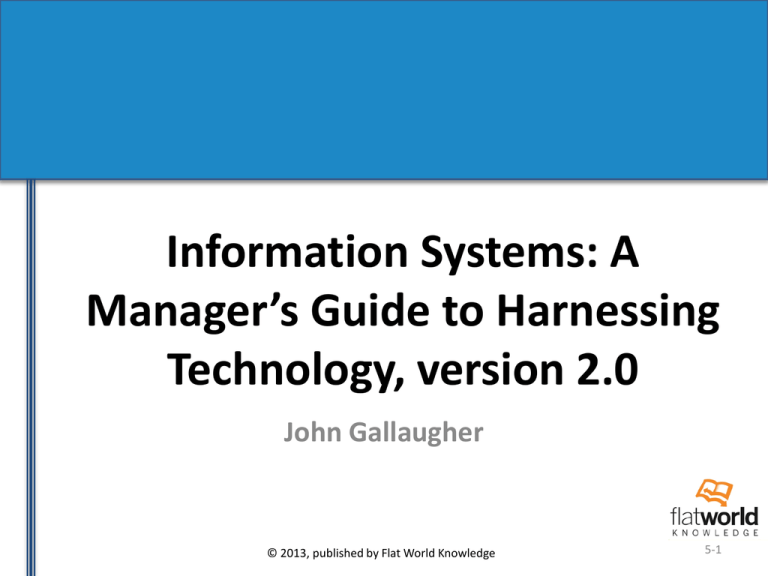
Information Systems: A
Manager’s Guide to Harnessing
Technology, version 2.0
John Gallaugher
© 2013, published by Flat World Knowledge
5-1
Published by:
Flat World Knowledge, Inc.
© 2013 by Flat World Knowledge, Inc. All rights reserved. Your use of this work is subject to
the License Agreement available here http://www.flatworldknowledge.com/legal. No part of
this work may be used, modified, or reproduced in any form or by any means except as
expressly permitted under the License Agreement.
© 2013, published by Flat World Knowledge
5-2
Chapter 5
Moore’s Law and More: Fast, Cheap
Computing, Disruptive Innovation, and
What This Means for the Manager
© 2013, published by Flat World Knowledge
5-3
Learning Objectives
• Define Moore’s Law and understand the approximate
rate of advancement for other technologies,
including magnetic storage (disk drives) and
telecommunications (fiber-optic transmission)
• Understand how the price elasticity associated with
faster and cheaper technologies opens new markets,
creates new opportunities for firms and society, and
can catalyze industry disruption
© 2013, published by Flat World Knowledge
5-4
Learning Objectives
• Recognize and define various terms for measuring
data capacity
• Consider the managerial implication of faster and
cheaper computing on areas such as strategic
planning, inventory, and accounting
© 2013, published by Flat World Knowledge
5-5
Some Definitions
Moore’s Law
• Chip performance per dollar doubles every eighteen months
Microprocessor
• Part of the computer that executes the instructions of a computer
program
Random-access memory (RAM)
• Fast, chip-based volatile storage in a computing device
Volatile memory
• Storage that is wiped clean when power is cut off from a device
© 2013, published by Flat World Knowledge
5-6
Some Definitions
Nonvolatile memory
• Storage that retains data even when powered down
Flash memory
• Nonvolatile, chip-based storage
Solid state electronics
• Semiconductor-based devices
Semiconductors
• Substance such as silicon dioxide used inside most computer chips that is
capable of enabling and inhibiting the flow of electricity
Optical fiber line
• High-speed glass or plastic-lined networking cable used in telecommunications
© 2013, published by Flat World Knowledge
5-7
Figure 5.1 - Advancing Rates of Technology
(Silicon, Storage, Telecom)
© 2013, published by Flat World Knowledge
5-8
Get Out Your Crystal Ball
• Price elasticity: Rate at which the demand for a
product or service fluctuates with price change
• Evolving waves of computing
–
–
–
–
–
–
1960s - Mainframe computers
1970s - Minicomputers
1980s - PCs
1990s - Internet computing
2000s - Smartphone revolution
2010s - Pervasive computing
© 2013, published by Flat World Knowledge
5-9
Internet of Things
• Vision of embedding low-cost sensors, processors,
and communication into a wide array of products
and the environment
– Allow a vast network to collect data, analyze input,
and automatically coordinate collective action
© 2013, published by Flat World Knowledge
5-10
Learning Objectives
• Describe why Moore’s Law continues to advance and
discuss the physical limitations of this advancement
• Name and describe various technologies that may
extend the life of Moore’s Law
• Discuss the limitations of each of these approaches
© 2013, published by Flat World Knowledge
5-11
The Death of Moore’s Law?
• Moore’s Law is possible because the distance
between the pathways inside silicon chips gets
smaller with each successive generation
– Fabs: Semiconductor fabrication facilities
– Silicon wafer: Thin, circular slice of material used to
create semiconductor device
© 2013, published by Flat World Knowledge
5-12
The Death of Moore’s Law?
• Packing pathways tightly together creates problems
associated with three interrelated forces
– Size
– Heat
– Power
• Chip starts to melt when the processor gets smaller
– Need to cool modern data centers draws a lot of
power and that costs a lot of money
• Quantum tunneling kicks in when chips get smaller
© 2013, published by Flat World Knowledge
5-13
Buying Time
• Multicore microprocessors: Contains two or more
calculating processor cores on the same piece of
silicon
• Multicore chips outperform a single speedy chip,
while running cooler and drawing less power
• Now mainstream, most PCs and laptops sold have at
least a two-core (dual-core) processor
• Can run older software written for single-brain chips
by using only one core at a time
© 2013, published by Flat World Knowledge
5-14
Buying Time
• Firms are radically boosting speed and efficiency of
chips
– Taking chips from being paper-flat devices to built-up
3-D affairs
– Transistors - Supertiny on-off switches in a chip that
work collectively to calculate or store things in
memory
© 2013, published by Flat World Knowledge
5-15
Learning Objectives
• Understand the differences between
supercomputing, grid computing, cluster computing,
and cloud computing
• Describe how grid computing can transform the
economics of supercomputing
• Recognize that these technologies provide the
backbone of remote computing resources used in
cloud computing
© 2013, published by Flat World Knowledge
5-16
Learning Objectives
• Understand the characteristics of problems that are
and are not well suited for parallel processing found
in modern supercomputing, grid computing, cluster
computing, and multi-core processors. Also be able
to discuss how network latency places limits on
offloading computing to the cloud
© 2013, published by Flat World Knowledge
5-17
Bringing Brains Together
• Supercomputers: Computers that are among the
fastest of any in the world at the time of their
introduction
• Supercomputing was once considered the domain of
governments and high-end research labs
• Modern supercomputing is done by massively
parallel processing
– Massively parallel: Computers designed with many
microprocessors that work together, simultaneously,
to solve problems
© 2013, published by Flat World Knowledge
5-18
Bringing Brains Together
• Grid computing: Uses special software to enable
several computers to work together on a common
problem as if they were a massively parallel
supercomputer
• Cluster computing: Connecting server computers via
software and networking so that their resources can
be used to collectively solve computing tasks
© 2013, published by Flat World Knowledge
5-19
Bringing Brains Together
• Multicore, massively parallel, grid, and cluster
computing are all related
– Each attempts to lash together multiple computing
devices so that they can work together to solve
problems
• Software as a service (SaaS): Form of cloud
computing where a firm subscribes to a third party
software and receives a service that is delivered
online
© 2013, published by Flat World Knowledge
5-20
Bringing Brains Together
• Cloud computing: Replacing computing resources
with services provided over the Internet
– Server farms: Massive network of computer servers
running software to coordinate their collective use
– Latency: Delay in networking and data transfer speeds
• Low latency systems are faster systems
• Moore’s Law will likely hit its physical limit soon
– Still-experimental quantum computing, could make
computers more powerful
© 2013, published by Flat World Knowledge
5-21
Learning Objectives
• Identify the two characteristics of disruptive
innovations
• Understand why dominant firms often fail to
capitalize on disruptive innovations
• Suggest techniques to identify potentially disruptive
technologies and to effectively nurture their
experimentation and development
© 2013, published by Flat World Knowledge
5-22
Characteristics of Disruptive Technologies
• They come to market with a set of performance
attributes that existing customers do not value
• Over time the performance attributes improve to the
point where they invade established markets
© 2013, published by Flat World Knowledge
5-23
Figure 5.3 - The Giant Killer
Source: Adapted from Shareholder Presentation by Jeff Bezos, Amazon.com, 2006.
© 2013, published by Flat World Knowledge
5-24
Why Big Firms Fail
• Failure to see disruptive innovations as a threat
– Reason - They do not dedicate resources to
developing the potential technology since these
markets do not look attractive
• Creates blindness by an otherwise rational focus on
customer demands and financial performance
• Start ups amass expertise
– Big firms are forced to play catch-up
• Few ever close the gap with the new leaders
© 2013, published by Flat World Knowledge
5-25
Recognizing Potentially Disruptive
Innovations
• Remove short-sighted, customer-focused, and
bottom-line-obsessed blinders
• Have conversations with those on the experimental
edge of advancements
• Increase conversations across product groups and
between managers and technologists
• If employees are quitting to join a technology, it
might be worth considering
© 2013, published by Flat World Knowledge
5-26
When a Potential Disruptor is Spotted
• Build a portfolio of options on emerging
technologies, investing in firms, start-ups, or internal
efforts
– Focusing solely on what may or may not turn out to
be the next big thing
• Options give the firm the right to continue and
increase funding as a technology shows promise
© 2013, published by Flat World Knowledge
5-27
When a Potential Disruptor is Spotted
• If a firm has a stake in a start-up, it may consider
acquiring the firm
– If it supports a separate division, it can invest more
resources if that division shows promise
• Encourage new market and technology development
– Focus while isolating the firm from a creosote bush
type of resource sapping from potentially competing
cash-cow efforts
© 2013, published by Flat World Knowledge
5-28
Learning Objectives
• Understand the magnitude of the environmental
issues caused by rapidly obsolete, faster and cheaper
computing
• Explain the limitations of approaches attempting to
tackle e-waste
© 2013, published by Flat World Knowledge
5-29
Learning Objectives
• Understand the risks firms are exposed to when not
fully considering the lifecycle of the products they
sell or consume
• Ask questions that expose concerning ethical issues
in a firm or partner’s products and processes, and
that help the manager behave more responsibly
© 2013, published by Flat World Knowledge
5-30
E-waste
• Discarded, often obsolete technology
• May be toxic since many components contain
harmful materials such as lead, cadmium, and
mercury
• It also contains small bits of increasingly valuable
metals such as silver, platinum, and copper
• Requires recycling, which is extremely labor intensive
– Most of the waste is exported for recycling
© 2013, published by Flat World Knowledge
5-31
E-waste
• Managers must consider and plan for the waste
created by their:
– Products, services, and technology used by the
organization
• Managers must audit disposal and recycling partners
with the same vigor as their suppliers and other
corporate partners
© 2013, published by Flat World Knowledge
5-32

